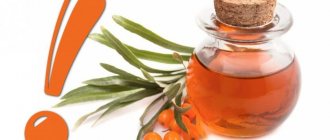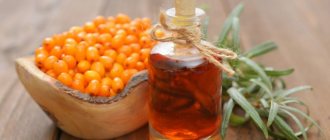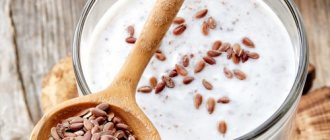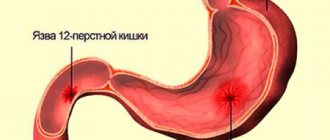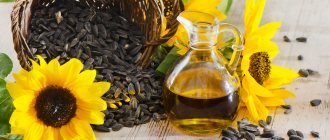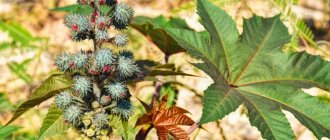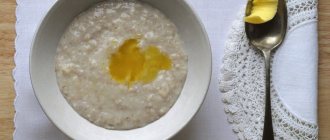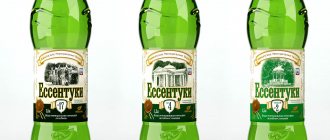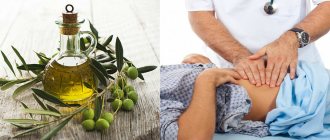Useful qualities of sea buckthorn oil
- The benefits of the product are as follows:
- reduces the acidity of juice in the gastrointestinal tract;
- improves liver and intestinal function;
- helps with gastritis and stomach ulcers;
- normalizes blood pressure;
- prevents the development of kidney stones;
- strengthens the walls of blood vessels;
- normalizes blood clotting;
- lowers blood cholesterol levels.
Sea buckthorn oil is also often used to prevent atherosclerosis and coronary heart disease. The beneficial properties of this remedy help prevent heart attack and stroke. It is recommended to use it in cases of alcohol poisoning. Considering that it contains immune system stimulants, this substance helps fight the runny nose, sinusitis and various viral diseases.
When the first symptoms of stomatitis (mouth ulcers) appear, it is necessary to make compresses from the sea buckthorn product in question. It is also used to support women's health, helping in the treatment of cervical erosion and candidiasis. During pregnancy, some girls use this substance externally to prevent the development of stretch marks.
Did you know? In Ancient Greece, sea buckthorn was believed to be Pegasus’s favorite delicacy.
Sea buckthorn oil can be used during post-operative recovery, as it prevents the development of bacteria and germs . This product is often used for cosmetic purposes. With its help you can get rid of wrinkles, age spots and improve the condition of your hair.
Making oil at home
There are several ways to obtain sea buckthorn oil. If you have a large harvest of this valuable berry and you don’t know where to use it, try making oil from it. Even if you are completely healthy, it will be useful as a preventive measure.
Let's look at the two most popular ways to prepare sea buckthorn oil at home.
Method 1
Prepare juice from thoroughly washed and dried sea buckthorn berries on a cotton towel (to drain the moisture). The simplest juicer and (in the absence of one) a sieve with a wooden spoon are suitable for this. Pour the resulting liquid into a dark glass jar, screw on the lid and put it in a cool place. After some time, you will notice that the juice has begun to separate: a layer of oil has formed in the upper part of the mass. When the peeling process is complete, carefully collect it and pour it into another container of a suitable color and volume - for example, into a bottle of ethyl alcohol, which must be tightly capped to prevent moisture and foreign substances from entering it.
The cake that remains after extracting the juice from the berries is also useful. Weigh it. Let's say you get 150 grams. It needs to be filled with refined sunflower oil - for one part of the extract there are five parts of oil, that is, 750 milliliters. Put the resulting mixture in a cool place for a week, and when it is infused, strain and can be used in the same way as the first.
Method 2
Prepare juice from sea buckthorn berries according to the previous recipe. We put it in a dark place for several days so that the oil separates. When the first layer of oil is removed, put the juice back in its original place and wait for a new portion of oil to appear (there will be much less of it). Let's take it off too. After the third time, the remaining juice can be poured out. You have obtained natural sea buckthorn oil of excellent quality.
What to do with the pomace? There are many useful substances left in them, which would be an unforgivable waste to send to the trash can. Dry them in the oven, grind them in a meat grinder and transfer a fifth of the resulting mass into an enamel saucepan (say, 2 tablespoons). Fill it with half a liter of vegetable oil (corn, sunflower or olive). Place in a warm oven and simmer for an hour. Then strain, add two more spoons of pomace and simmer again for an hour in the oven. Repeat this procedure until all the pulp is gone. As a result, you will have another portion of excellent oil, rich dark orange in color, exuding a characteristic sea buckthorn aroma. It can be used in the same way as a completely natural one - both products are of high quality and have all the beneficial properties inherent in a pharmaceutical drug.
Is it possible to take sea buckthorn oil for esophagitis?
When the first symptoms of reflux esophagitis appear, begin treatment immediately. First you need to undergo a medical examination to determine the extent of the disease. After this, the doctor will prescribe you medications that will speed up your recovery.
The substance in question can be used as an additional means of treatment: on its own it will not be able to rid you of the disease. To notice a positive result, you should use this folk remedy correctly. An overdose of them can only provoke a deterioration in health and cause an exacerbation of esophagitis.
Reflux esophagitis. Causes
gastroesophageal reflux (reflux) of gastric contents, caused by a decrease in the lower esophageal sphincter and slower gastric emptying,- increased acidity of gastric juice,
- bile and pancreatic enzymes that have an alkaline reaction,
- decreased resistance of the esophageal mucosa to damaging factors,
- restoration (regeneration) of the mucous membrane,
- disturbance of blood supply (microcirculation),
- reduction of alkalizing components (bicarbonates).
Clinical manifestations of peptic esophagitis, its complications, and diagnosis do not differ from those with hiatal hernia and gastroesophageal reflux disease.
Treatment of the esophagus with sea buckthorn oil
When treating gastrointestinal diseases, the described sea buckthorn product should be taken orally. Complete cure occurs 30–40 days after starting treatment.
Important! The course of treatment and optimal dosages should be prescribed by the attending physician.
The product should be taken half an hour after meals. For an adult, the maximum amount is 1 tbsp. l. It must be taken 3 times a day. For children, the dosage is reduced to 0.5 tsp. 2 times a day. If you consume sea buckthorn oil before meals, you can avoid side effects (diarrhea, nausea, heartburn, etc.).
Nutrition correction
With the first appearance of signs of gastroesophageal reflux with esophagitis, you should immediately adjust your diet. It is advisable to refrain from fatty, fried and spicy foods, which only increase the production of gastric juice. When consuming sea buckthorn oil, add foods containing phosphorus and magnesium (seafood, vegetables) to your diet. They will only enhance the effect of the folk remedy.
Important! Try to eat small portions so as not to overload your stomach and intestines. So the substances contained in the oil will envelop the gastrointestinal tract and speed up recovery.
Esophagus burn
First aid for a burn of the esophagus can be provided at the prehospital stage or in the surgical and intensive care departments. Immediately after receiving a burn to the esophagus, you should rinse your mouth with plenty of clean water at room temperature and drink two glasses of milk. Inducing vomiting to remove a chemical from the stomach is not recommended as this may cause rupture of the esophagus.
After admission to the hospital, a gastric tube is inserted, abundantly irrigated with oil. Before inserting the probe, local anesthesia is applied to the oral and pharyngeal mucosa. The contents of the stomach are removed through the tube and the damaging substance is inactivated. In case of a burn with alkali, the stomach is washed with a non-concentrated solution of acetic acid or oil; the acid is neutralized with a soda solution. If it is not known exactly what caused the burn, it is recommended to rinse the stomach with plenty of water or introduce milk through a tube. The stomach should be rinsed only in the first six hours after receiving a burn; in the future, this procedure is not advisable.
Immediately after inactivation of the damaging agent, an antibiotic is administered to prevent purulent complications, the patient is anesthetized and sedated, and detoxification and anti-shock therapy begins. With a first-degree burn of the esophagus, you can start feeding the patient already on the second or third day of hospital stay. In case of a second degree burn, feeding does not begin until the seventh or eighth day. In case of third degree burns, the issue of enteral nutrition is decided on an individual basis.
On the seventh to tenth day after receiving the burn, bougienage of the esophagus begins. The procedure involves daily insertion of bougies of increasing diameter into the lumen of the esophagus, which helps to expand the lumen and reduce scarring. If in the acute period of the burn therapeutic measures were carried out in full, and in the subacute phase the esophagus was properly bougienage, then satisfactory results of restoring the patency of the esophagus are achieved in 90% of cases.
If, in the long term, severe cicatricial strictures, significant stenosis of the esophagus, or its complete obstruction develop, surgical treatment is performed (stenting of the esophagus, endoscopic dissection of cicatricial stricture of the esophagus, endoscopic expansion of esophageal stenosis, esophageal plastic surgery).
Forecast and prevention of esophageal burn
The prognosis for a burn of the esophagus is determined by the type, amount and concentration of the chemical solution; severity of the burn; pH level of the liquid (the most severe damage develops at a pH below 2 and above 12); correct provision of first and further medical aid; the presence and severity of complications. The most unfavorable prognosis for third-degree burns of the esophagus is that mortality in this group reaches 60%. In other patients, the prognosis is more favorable; with proper assistance, normal functioning of the esophagus is maintained in 90% of patients. Prevention of burns to the esophagus means following the rules for storing hazardous and caustic substances: separately from drinks and food, out of the reach of children, in specially marked containers.
Contraindications for use
- You should not use oil in the following cases:
- During pregnancy and lactation.
- For individual intolerance and allergies.
- For cholecystitis and pancreatitis.
- Children under 12 years old.
Those who have signs of diabetes should take sea buckthorn oil with caution. Also, this remedy is not combined with vasoconstrictor drugs.
In addition to its beneficial properties, the folk remedy made from sea buckthorn has a number of contraindications.
So, now you know how to properly use sea buckthorn oil for gastroesophageal reflux with esophagitis. If you do not violate the prescribed dosage and monitor your diet, then within a month you will see a positive result.
Symptoms
With esophagitis, body temperature may rise, general malaise is noted, and unpleasant sensations appear along the esophagus during the passage of food.
The child may be bothered by a burning sensation, sometimes sharp pain in the esophagus. Children are often capricious and refuse to eat for fear of pain after the first sips of food; they may complain of pain in the neck, belching, frequent regurgitation, drooling, and difficulty swallowing. Chronic esophagitis is a chronic inflammation of the wall of the esophagus. The disease can develop with insufficiently treated acute esophagitis or as a primary chronic process. Chronic esophagitis is accompanied by pain behind the sternum and in the epigastric region; it is often combined with gastritis or duodenitis, which gives a varied clinical picture.
Children cannot always clearly explain their feelings. Older children complain of a feeling of rawness in the chest immediately after swallowing food; Pain may also appear that is independent of food intake, especially while running, jumping or forced breathing. Sometimes pain occurs when lying on your back; it can be in the form of attacks and radiate to the neck, back or heart area. In most cases, children also belch with air or with an admixture of gastric contents after eating and physical activity. Older children complain of heartburn, especially in the evening and at night; Nausea, vomiting, regurgitation of food, hiccups, drooling, and difficulty breathing are also possible. Hiccups usually begin after burping and continue for a long time.
During chronic esophagitis there are periodic exacerbations and remissions. If treatment begins late and esophagitis progresses steadily, scarring of the esophagus may form.
